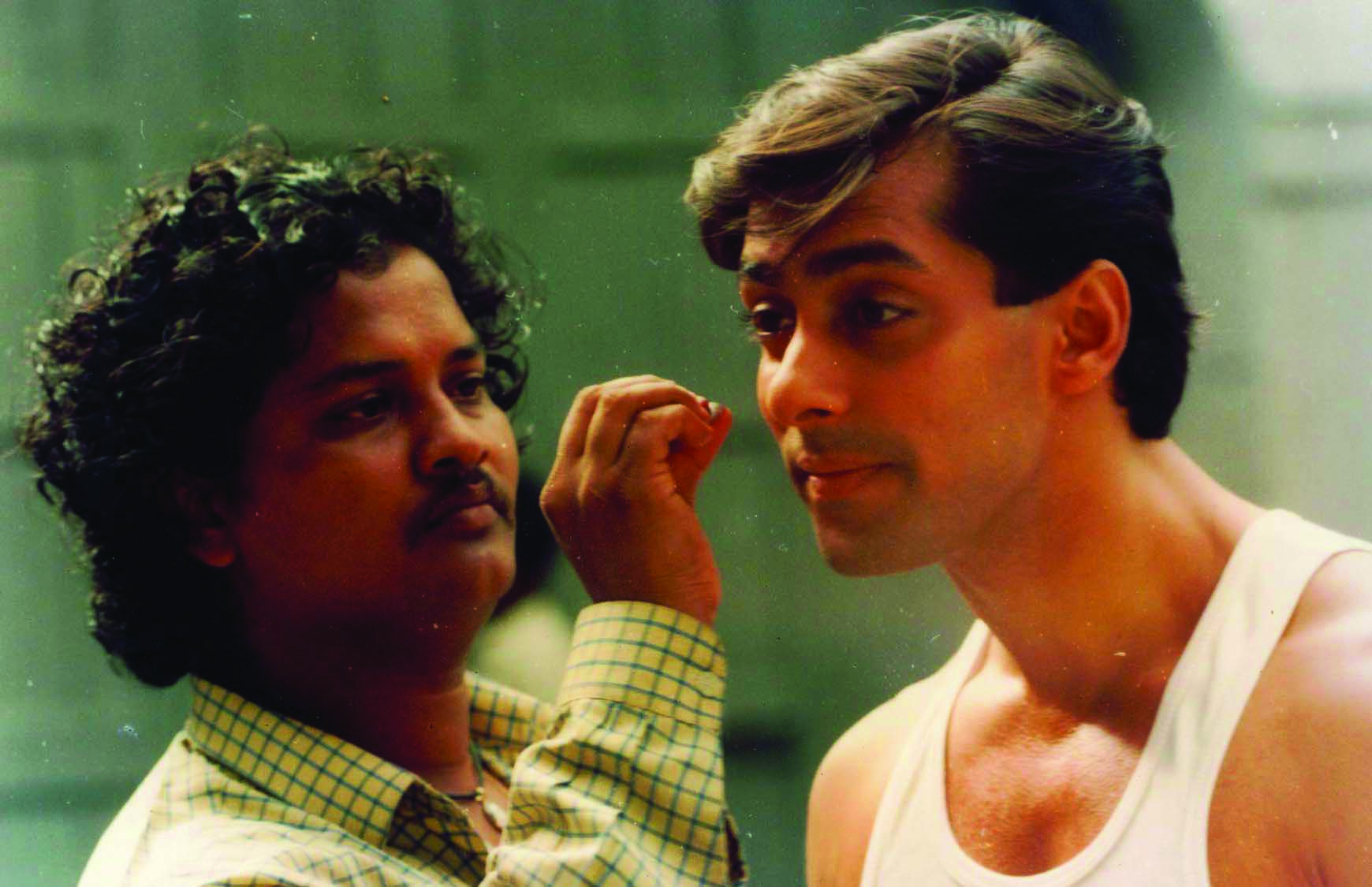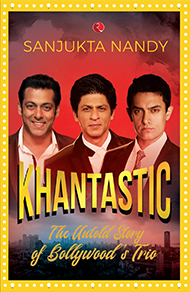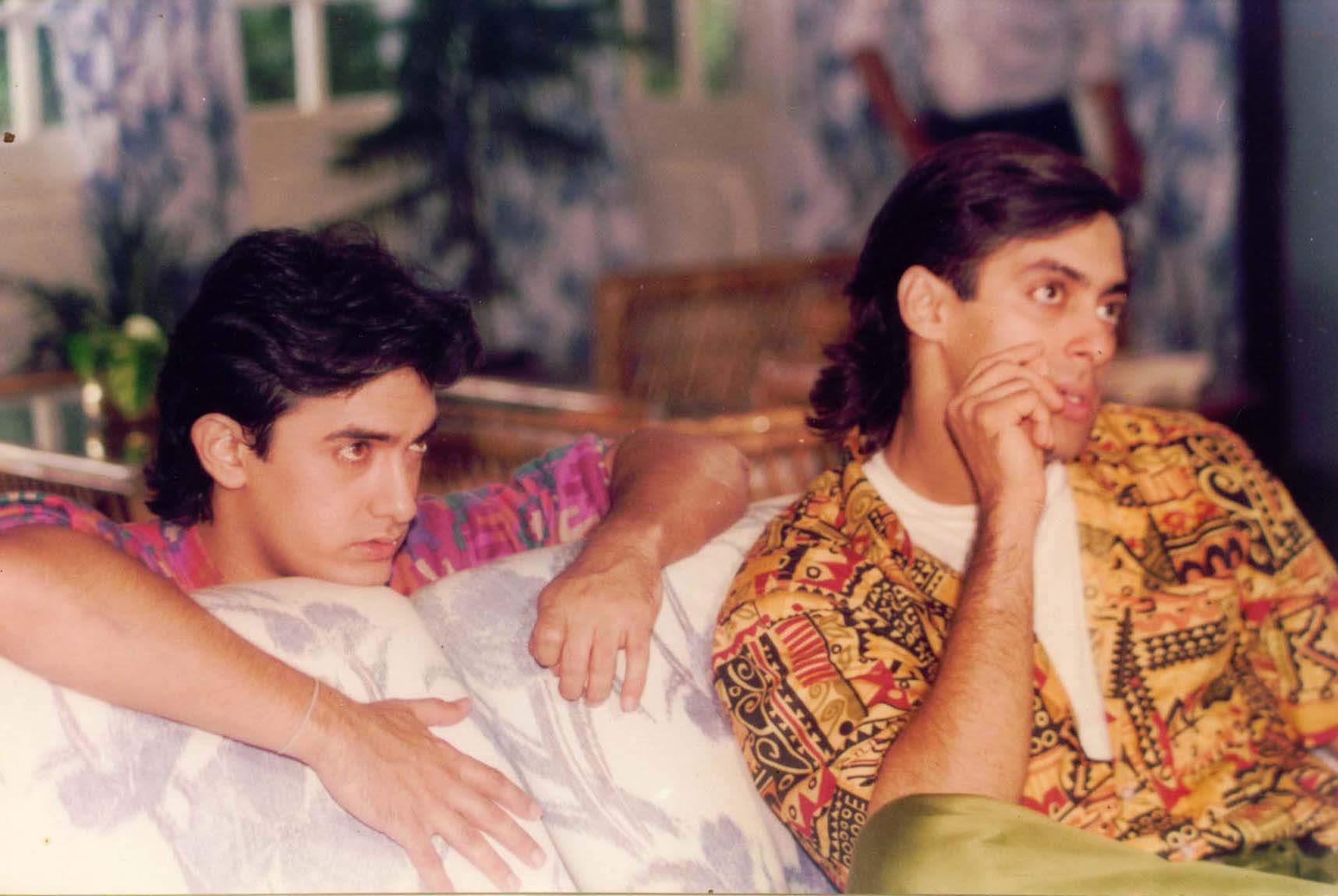Salman Khan: The Sultan as Superstar – An Excerpt from ‘Khantastic’

The 6.5-pound baby boy, born in Kalyanmal Nursing Home, Indore, on 27 December 1965, was sharp, active and winced at the slightest sound. His aunt, Sufiya Khan, noticed that even as an infant, he had opened his eyes right after birth. Unlike most infants, he—Abdul Rashid Salim Salman—would gaze around, as if he had come to survey the world.
Today, on the 54th birthday of the superstar, we bring to you an exclusive extract from Sanjukta Nandy’s Khantastic, narrating Salman Khan’s initiation into the movies!

Aamir had once said about Salman, ‘In Andaz Apna Apna, I had a very bad experience of working with him. I did not like him. I found him rude and inconsiderate.’ However, in the next breath, Aamir confessed, ‘For me, to give a big success, I have to have a great script, a great director and each technician has to contribute fully for the film to come out well and to do well. But Salman doesn’t need that yaar. He is just raw, brute, star power. He just comes, shakes his belt a couple of times, puts his goggles behind his shirt and everyone just goes bananas. I don’t have that kind of stardom.’

Salman’s stardom had a meteoric rise with Maine Pyar Kiya. But many believed that it was Sooraj Barjatya and Bhagyashree who got the bigger bite of the industry limelight rather than Salman because for a good number of months, Salman did not get any film offers. It was only when a worried Salim Khan requested G.P. Sippy to just announce a film with Salman, to create a buzz in the trade, that the tide turned. The outcome was however, unexpected.
Ramesh Taurani, who had launched Tips Industries, a music production company, read the announcement of Sippy’s Patthar Ke Phool starring Salman, with interest. At that time, he was on the lookout to buy the rights for music of new films. The music of Maine Pyar Kiya had done very well and so he decided to buy the music rights of Patthar Ke Phool. He was unaware that it was only an announcement for a film that was not going to be made.
On the following Monday morning, his first call was to Sippy. Taurani introduced himself and expressed an eagerness to meet him. As soon as Sippy gave the nod, Taurani hopped over to Sippy’s office with an offer. He put down the money for the music rights of Patthar Ke Phool.
This was a pleasant surprise. Once Taurani showed his interest and confidence in the project, Raveena Tandon, who had then been noticed in a few ad films, was signed on and the stillborn project came alive. There was no looking back for Salman. In February 1991, Patthar Ke Phool rocked the box office.
Go Straight and Turn Right
But the release of this film wasn’t Salman’s immediate release post Maine Pyar Kiya. Salman had always dreamed of being a writer like his father. The story idea of Baaghi: a rebel for love was credited to Salman although scripted by Javed Siddiqui. Though Patthar Ke Phool was signed first, Salman’s film, Baaghi, with Nagma as the heroine—released in December 1990—was a runaway hit.
But before the release of these films, film director Saawan Kumar Tak had called his friend Salim Khan and asked, ‘Salman kya kar raha hai? (What is Salman doing?)’. Salim saab said, ‘Kuch nahi…sofe pe letaa hai bekaar (Nothing, he is just lazing away on the sofa).’ Tak responded, ‘Bhej dijiyega, mere paas (Send him to me).’ Salman was at Tak’s place within an hour. First, he went to the fridge, ate some fruits and then went to Tak and said, ‘Aa gaya hoon (I’ve come).’ Tak looked at him for a while and asked, ‘Film shuru kare? (Should we start the film?)’
Tak had planned Sanam Bewafa with two villainous stalwarts, Danny Denzongpa and Pran. He wanted to cast a young boy for the romantic angle. Salman was ready and the film took off. Tak still fondly looks back and says the honest romance that Salman portrayed carried the film that proved to be a smash hit in January 1991.
The release of Sanam Bewafa was quickly followed by Patthar Ke Phool in February 1991. Three months, three films and Salman had scored a hat-trick of hits. In August 1991 came Saajan which too made it to the top of the charts, scorching box-office numbers. The music too was a runaway hit. Four hits after Maine Pyar Kiya and Salman was tagged as the Sensational Khan by the media.
Salman was an unstoppable hit machine. He was creating waves in the industry and was flooded by film offers. He was working double and even triple shifts that amounted to almost twenty-four hours of work every day. He mentioned in an interview, ‘All I heard resonating in my head was “light aa raha hai and light jaa raha hai (Bring the lights, take them away)”. ’
Those days, there were no vanity vans, so Salman had to sleep in his car. Luckily, his dad had a Mercedes-Benz with a comfortable back seat. But Salman’s driver, Laxman dada, who had aged by then, one day went up to him, gave him the car keys and called it a day. He left saying that if he continued to drive for Salman, and keep up with this maddening schedule, he would surely land up killing them all in a road accident. A new driver came in for Salman, who carried on the pace.
In spite of the sweat and hard work, some rude flops were waiting around the corner for Salman. He later confessed that he himself was responsible for it. He was eager to buy his own house. So to garner the funds, he signed films, without much forethought. Some of these were also signed in ‘yaari dosti’ (friendships). Salim Khan remembers that many times Salman would tell him to say ‘no’ to a friend on his behalf. Salman could never refuse anyone and his friends would convince him on emotional grounds to agree. As luck would have it, those films kept bombing one after another. Love, Suryavanshi, Ek Ladka Ek Ladki, Nishchaiy and Dil Tera Aashiq were all back-to-back flops.
One day, late in the night, concerned about Salman, Salim saab gave him some blunt advice, ‘If there is anybody, any man who can foul it all up for you, it’s going to be you! God doesn’t want it to happen, we, your family don’t want it to happen, and your fans most certainly don’t want that to happen. So, again, if there’s “anybody” who can mess it all up, it’s you!’ It was a wake-up call for Salman. His father’s words shook him up and grounded his focus. Both his brothers, Arbaaz and Sohail, supported their father’s advice and told Salman, ‘If anyone can kill Gabbar Singh from Sholay, it’s Gabbar himself.’ Salman became sharper, aware and motivated with his choices. He caught onto the vibes of professionalism and his father’s golden words, ‘In life, go “straight” and turn “right”. ’
Re-scripting Box-Office History
‘Straight and right’ was Sooraj Barjatya and Rajshri Productions with a film called Hum Aapke Hain Koun..! Sooraj and Salman had spun magic in 1989 with Maine Pyar Kiya and it was their next venture together. A film with no action, no negative characters and fourteen songs. The pitch for the film was that it had values, traditions and a spirit of sacrifice that lay deep within the heart of the average Indian. Salman was again named Prem, the same name he had donned in Maine Pyar Kiya. Before this film, people in the industry were scared to keep the name ‘Prem’ for a hero, as it reminded them of the villain, Prem Chopra. But when Sooraj and Salman joined hands, it was always a break from the mould.
When Salman and Sooraj made Maine Pyar Kiya, they cried at every poignant moment of their camaraderie. On the first day of Hum Aapke Hain Koun..! too, they both got emotional at the thought of teaming up together again, and wept.
The release of the film coincided with the declaration of 1994 by the United Nations General Assembly as ‘The International Year of the Family’. This family film, which many called an extended wedding video, had a screen full of characters, generally having fun, singing and dancing.
Spanning over a year, a big part of the film was shot in Ooty and in studios in Mumbai, especially Filmistan. The character of Prem was modelled on Salman himself. Prem was fun and energetic, similar to what Salman was on the sets.
Himani Shivpuri, who had come from Delhi with a theatre background, recalls that it was her first commercial film. Her debut scene was with Salman, who used to improvise a lot on the sets. He took her by complete surprise in the first shot itself. The scene in which Pooja Choudhury (Renuka Shahane) delivers her baby boy had a celebratory mood. Salman raised the momentum of the scene to another level of jubilation by hoisting Himani in his arms, and dancing with her. Sooraj and Himani were both flabbergasted, but the mood of the scene got an extra dose of impromptu cheer.
Salman’s inherent naughtiness translated into a lovable character on celluloid. His childish unscripted improvisations worked wonders as did his complete dedication to the film. Salman, allergic to dog hair, had a cold throughout the film. But he did all the scenes admirably, carrying Tuffy, the adorable Spitz, in his lap whenever and wherever it was required.
All the naughty interactions were planned by Sooraj but executed with an extra edge by Salman. The way Salman dealt with his co-stars, the children and even the dog was tender and honest. Everyone at the shoot noticed this quality and applauded. Between shots, the entire cast would team up and play games to de-stress and enjoy. The actors lived their roles in real life and the family-feeling filtered into their persona, which later reflected on screen and in the success of the film.
The wrap up of the shoot was extremely emotional. When any actor called in his last shot, the production would strum up a background song to bid them farewell. It was a song from the film itself, ‘Tum se judaa ho kar, hume door jana hai (I will have to bid you adieu and go far from you).’ This gesture made each of the actors, who gave their last shot, emotional. When it was Salman’s time to bide farewell, Salman and Sooraj kept up their tradition of crying and wept once again.
In a few months, it was time for the audience to cry. The emotional joyride swept the nation on 5 August 1994. The theatre, Liberty, in Bombay, was decorated like a wedding set with lighting and flowers all over. Rajshri Productions was a famous distributor itself and went ahead with a new pathbreaking release plan for the film. They had a single-platform release for Hum Aapke Hain Koun..! in Bombay. For other territories, they handpicked theatres for the film’s release and the prints were given to the exhibitors only after the theatres had agreed to upgrade the sound as well as visual quality as required.
The upgradation resulted in a huge hike in ticket rates, phenomenal for way back in the 1990s. Surprisingly, the families that did not visit the sub-standard, run-down theatres, came back in full force to watch the film. The film smashed all box-office records by an enormous margin. The release size of the film kept expanding every month and it went on for a successful run for over 150 weeks. It also raked in over`70 crore at the box office then and broke the previous record of the highest-grossing Indian film, Sholay. Taking inflation into account, Hum Aapke Hain Koun..! remains the highest-grossing Bollywood film ever. It was estimated that only in Liberty Cinema, South Bombay, twenty lakh patrons thronged to watch the film.
The film won five Filmfare awards, at the 40th year of the awards, including Best Film, Best Director and Best Actress, in addition to the National Film Award for Best Popular Film Providing Wholesome Entertainment. A special screening of the film was held for the then President of India, Shankar Dayal Sharma, at the Rashtrapati Bhavan. Dubbed in Tamil as Ambaalayam, it had a successful run. In Telegu, it was titled Premalayam and ran over hundred days in fourteen centres. Internationally, Hum Aapke Hain Koun..! ran successfully for fifty weeks in London’s Belle-Vue Cinema. The theatre was booked for only three weeks, as the property had to go for renovation. But the collection of the film was so tremendous that theatre owners decided to postpone the renovation. A musical production titled 14 songs, 2 weddings and a funeral, designed on the film, played successfully in the theatres of London. In Canada, the film ran in Toronto’s Albion Cinema for seventy-five weeks and was a runaway hit.
Madhuri was reportedly paid more than Salman for Hum Aapke Hain Koun..! But the box-office success of the film effortlessly slid Salman into the shoes of a superstar.
No hero, before Salman, had seen the mad hysteria that he was experiencing. Riding the wave of success, little did Salman know that come 1995, another Pathan would be sharing a part of the pie, and inscribing his name in the annals of history.
***
Get the book here.
***

